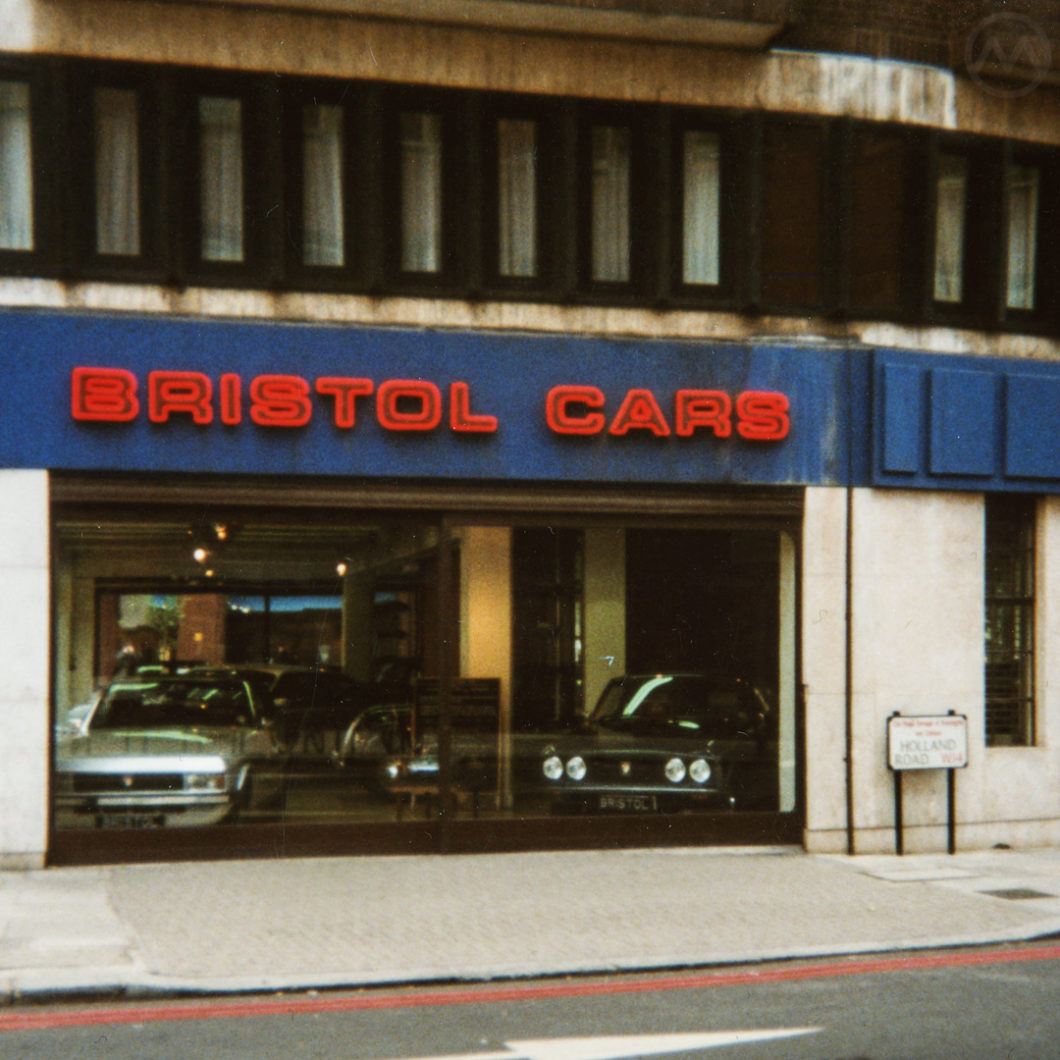It’s a somewhat sad flashback today looking back at Bristol Cars’ old Kensington showroom at a time when Bristol was still owned by the cantankerous but devoted Tony Crook, then in his late 70s.
The end finally came for the boutique British carmaker this week via liquidation for unpaid bills, though in truth no new Bristols have been built since 2011. The company went into receivership once before and was revived, and it showed a Morgan-based, retro-themed prototype in 2015, but after that very little happened. The end finally came, although reportedly the Bristol club and various enthusiasts are actively involved in preserving the spares and documentation of the now defunct company.
In the window in this 1990s shot you can see three different Bristol cars – a silver 412 (left), a black 411 (right), and what looks like a silver Brittania/Brigand behind. None were new, and the dealership (Bristol’s only store) sold new and used models of widely varying vintages.
The latter Bristols, post-1973, were old-school and huge, and did not change with the times. They kept the same basic proportions as the early sixties 407 right up until the early 2000s and the changes were evolutionary and the brand was definitely not a slave to fashion or trendiness.
Nor was Mr. Crook, who had a singular vision for what a Bristol should be like and had no qualms about voicing his taste.
Although considered an anachronism by the time Liam Gallagher and Paul Smith were interested in them in the years just before this photo, it was only Crook’s hard work and determination that got the make that far; but the roots went back a long way, to Bristol Aeroplanes.
Bristol Cars
Caught out by falling demand after WW1, Bristol Aircraft was rescued in part by building a small car, and then later bus and vehicle bodywork, to fill factory space. After WW2, the company didn’t want to be caught out again by falling demand for aviation products and ventured into the sports car business by buying out the Aldington Brothers’ Frazer-Nash company, which had marketed and modified BMW’s before the war.
The arrangement with Frazer-Nash ultimately didn’t work out, but Bristol licensed the BMW engine and technology from them, mutating the pre-war BMW 328 into the Bristol 400. After that, the company built fast GTs and supplied engines to AC and others until being spun off from the Aviation company (which became part of British Aircraft Corporation/BAC) in 1960.
Ownership of the now independent company was split between Sir George White, son of Bristol Aeroplane’s former managing director (who had set up the car biz in the first place), and Crook, the leading dealer of Bristol cars and a successful former race car driver until injuries forced his retirement in 1955.
Under the new regime the cars got Chrysler V8s in place of the old BMW-descended six, which was necessary as the cars had gotten bigger and heavier over time.
The Emporer of Kensington
With Crook being an owner, he became the lone distributor, and eventually took over the company entirely after White was injured in a car accident in 1969. In 1973, Crook became teh sole owner. In that position he presided over the gradual evolution of the cars, built at Filton, and their sale in Kensington.
They changed little in concept or purpose over the years, but people sometimes forget that he introduced the angular, Zagato-styled 412 (later Beaufighter) in 1975 and revised the main range into the Dudley Hobbs-styled Type 603 (later called the Brittania/Brigand/Blenheim) in 1976. These cars were not big sellers but they were tailored to a very specific clientele who wanted a stately, bespoke British GT and now could not get one from Alvis or Jensen.
Underneath, they owed much to their predecessors – which is why the proportions changed so little. They were the opposite of the Jensen Interceptor, however – understated and rarely seen and appreciated by a select clique of fans.
Crook did not advertise, would not quote production or performance figures, did not lend his cars to journalists, did not have set prices, and didn’t care about other people’s opinions. Dependent on Crook for service, Bristol owners were also models of discretion about such subjects. Any time a Bristol was referred to critically in the U.K. press, the editor of said publication could look forward to a multi-page hand-written response.
He was funny if occasionally caustic, and kept the firm in the black until 1997, when he sold a 50% stake, then selling out entirely in 2002. Whatever his eccentricities (and they were many), he kept Bristol profitable and alive for decades before the new owners locked him out in 2007.
Denouement
Without him, they quickly ran into trouble. Bristols are extremely rare stateside, although we did photograph one in Canada in 2018. Hopefully we’ll get out to the UK to bring you one sometime soon (though who knows with the rest of 2020’s chaos going on).
Visitors to Kensington today will still find the Bristol showroom, with its signage now updated from a later era, at least for a little while. The surrounding blocks are almost entirely different as old construction has given way to new. Soon only the “Holland Road” sign will remain.


Were you “invited” by someone in the know to visit the Kensington showroom, or could you just turn up to have a look?
The latter. Although if you wanted to get in the cars and spend any time there, you’d need an appointment.